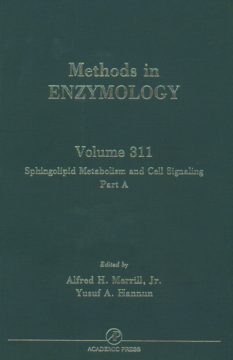
BOOK
Sphingolipid Metabolism and Cell Signaling, Part A
John N. Abelson | Melvin I. Simon | Alfred H. Merrill, Jr. | Yusuf A. Hannun
(1999)
Additional Information
Book Details
Abstract
Sphingolipids are found in all eukaryotic and in some prokaryotic organisms and provide structure for cell membranes, lipoproteins, and other biological materials as well as participate in the regulation of cell growth, differentiation, and diverse cell functions, including cell-cell communication, cell-substratum interactions, and intracellular signal transduction. This volume presents methods used in studying enzymes of sphingolipid biosynthesis and turnover, including inhibitors of some of these enzymes, genetic approaches, and organic and enzymatic syntheses of sphingolipids and analogs. Its companion Volume 312 will contain information on analyzing sphingolipids, sphingolipid transport and trafficking, and sphingolipid-protein interactions and cellular targets.
The critically acclaimed laboratory standard for more than forty years, Methods in Enzymology is one of the most highly respected publications in the field of biochemistry. Since 1955, each volume has been eagerly awaited, frequently consulted, and praised by researchers and reviewers alike. Now with more than 300 volumes (all of them still in print), the series contains much material still relevant today--truly an essential publication for researchers in all fields of life sciences.
PRAISE FOR THE SERIES
"The 'Methods in Enzymology' series represents the gold-standard."
-NEUROSCIENCE
"Incomparably useful."
-ANALYTICAL BIOCHEMISTRY
"It is a true 'methods' series, including almost every detail from basic theory to sources of equipment and reagents, with timely documentation provided on each page."
-BIO/TECHNOLOGY
"The series has been following the growing, changing and creation of new areas of science. It should be on the shelves of all libraries in the world as a whole collection."
-CHEMISTRY IN INDUSTRY
"The appearance of another volume in that excellent series, Methods in Enzymology, is always a cause for appreciation for those who wish to successfully carry out a particular technique or prepare an enzyme or metabolic intermediate without the tiresome prospect of searching through unfamiliar literature and perhaps selecting an unproven method which is not easily reproduced."
-AMERICAN SOCIETY OF MICROBIOLOGY NEWS
"If we had some way to find the work most often consulted in the laboratory, it could well be Colowick and Kaplan's multivolume series Methods in Enzymology...a great work."
-ENZYMOLOGIA
"A series that has established itself as a definitive reference for biochemists."
-JOURNAL OF CHROMATOGRAPHY
